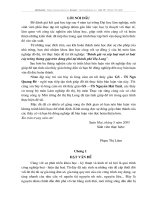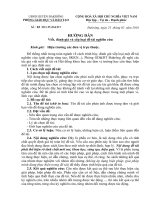Chuyên đề: Đánh giá và xếp loại E11
Bạn đang xem bản rút gọn của tài liệu. Xem và tải ngay bản đầy đủ của tài liệu tại đây (92.7 KB, 14 trang )
Methodology-E.11- Intensive Program
Testing
Presented by Lê Kim Tường
TESTING & ASSESSMENT
Questions for discussion
1.State what you know about innovation/change in
testing and assessment.
2.List some test types you usually give your 11-grade
students.
3.Suggest what should be done to make fair tests.
Follow-up activity
In groups, choose one point to be tested (either
language skills or vocabulary or grammar or
pronunciation). Design a 45-minute test with key
answers.
Innovation/Change in Testing
In traditional language teaching, formal and informal tests are
given to students by their teachers.
Nowadays, based on student-centered approach, language
testing includes tests, continuous/continual assessments.
- Formal tests are given to students at the end of a semester/
school year, marked, and assessed by teachers.
- Continuous/continual assessments are informal tests given
regularly to students during the course. They are assessed by
teachers( teacher assessment), or classmates (peer
assessment), or the student himself/ herself (self-assessment).
Note to the teacher
PEER OBSERVATION & EVALUATION ( for advanced
discussion skills only)
According to Green (2002:225), peer evaluation may be carried out
in one, two, or all of three main ways:
Observer ring. While a group conducts its discussion, the
observer-evaluators sit with the discussion group and monitor
the proceedings. Observers need to complete observation and
evaluation sheet.
Shadowing. Shadowing provides for intensive one to one
evaluation. A specified member of the partner group sits next to
or behind a discussion group participant. At a prearranged point
in the discussion, the shadow may substitute for the participant
and adopt his/her line of argument
Using video and audio recorders. The recording of each group
should be made away from the classroom in a quiet space to
obtain excellent results.
Testing and Assessment
“…Testing is one kind of assessment. One which is typically
used at the end of a stage of instruction to measure student
achievement. Assessment is a broader concept: it is part of the
whole educational process of teaching and learning…”
“…Whilst tests can be used as a ‘bolt-on’ procedure at end-
points in a learning program, assessment is integral to the whole
process of teaching and learning…”
Assessment is undertaken and for different purposes. The first
purpose is pedagogically motivated, i.e. formative assessment.
The second one is to measure learner achievement, i.e.
summative assessment.
Source: Hedge, T. (2000). Teaching and Learning in the Language
Classroom, OUP .(pp 336-337)









